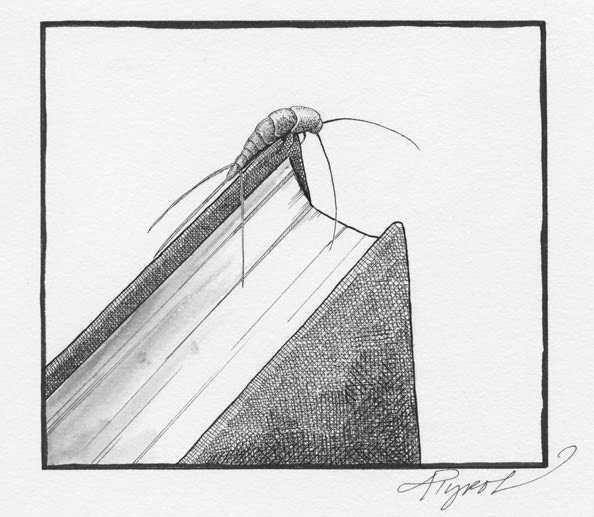
This afternoon, a 390-million-year-old thysanuran paid me a visit on my desk. It wasn’t really that old, just a little creature whose uninterrupted ancestry dates back at least that far. It’s called a silverfish. It’s also a nuisance.
A thysanuran is one of the most ancient members of a group of animals consisting mostly of insects —the hexapods. Although silverfish are primitive, they represent a link between early wingless hexapods and those with wings (insects), a major evolutionary split that occurred long ago.
The creature’s name comes partly from the silvery scales that flake off its body like shiny dust and partly because of its preference for cool, damp places that for some reason suggested “fish” to someone. The slender, flattened little animal is not at all fish-like.
A silverfish’s most distinctive features are long antennae and curious tail filaments, showing that a sense of touch is essential, while vision is not. (Silverfish eyes are small.) Preferring to remain in confined and secluded places, sensing vibrations and physical surroundings are critical to survival.
When a silverfish is disturbed it scuttles away to a hiding place, squeezing its flattened body into the narrowest possible space. The tiny animal is almost impossible to pick up, but if you touch it a powder of silvery scales sticks to your fingers.
Silverfish prefer cool places with high relative humidity; bathrooms and cellars are just fine. They scavenge in the open after dark, but as soon as lights are turned on they flee. Sometimes one gets trapped in a sink or bathtub where smooth sides prevent climbing out. During the day, if you suddenly expose its refuge by lifting an object, a silverfish may even jump in alarm or run sideways in its haste to escape. Outdoors they live relatively undisturbed under stones, bark, logs, and leaf litter, feeding quietly on decayed plant material and fungi. Inside, however, the damage they do can be irreparable as they eat starched clothing, pasted wallpaper, photographs, cereal, leather and paper—especially pages in books and manuscripts.
Silverfish survive difficult conditions. Despite their preference for humidity, they are able to resist arid conditions and can survive in dry attics munching on old magazines, cardboard cartons, and fabrics. They also have a very slow metabolic rate and can live many months without food.
Although thysanuran reproduction is slow and simple, they engage in simple ceremonial behavior that helps to transfer sperm without actual contact. The male spins a silken thread between the substrate and an overhead object. There he places a package of sperm, called a spermatophore. Before leaving the scene, he encourages a female to approach the spot.
She locates and picks up the sperm packet with her tail bristles and places it in her reproductive opening where fertilization of eggs takes place. Not one to waste good protein nourishment, the female then eats the empty spermatophore.
She lays two or three tiny whitish eggs in a crack or under debris before moving on to other, similar sites to lay a few more. Over her lifetime a female silverfish produces about 100 eggs.
Young hatchling silverfish are tiny, white replicas of their parents. Adult coloration develops gradually as they molt and grow. They reach adult size in about two years and with good luck live up to eight years.
Were you to seek the origin of hexapods in the remains of early coal forests, you’d find thysanuran fossils that are almost indistinguishable from today’s forms. The oldest identifiable hexapod fossil ever found – a 390 million-year-old silverfish – was discovered just north of here in Quebec.
They came into existence long before winged insects appeared, so for them little has changed. With no metamorphosis whatsoever in reproduction, a silverfish or firebrat emerges as a smaller version of what it will be in adulthood—another archaic characteristic.
Tidy housekeepers don’t want an infestation of silverfish, especially since a large population indicates a humidity problem in a house. There are no effective preventive measures, other than keeping humidity down, fixing plumbing leaks, clearing out clutter, and lighting up dark areas.
Because silverfish in Vermont and New Hampshire are mostly outdoor varieties, paper-eating doesn’t seem to be a local problem, so I suspect my desktop visitor was simply enjoying an alternative to being outside. But when I lived in Delaware, my loss of books, lecture notes, and manuscript copy were more than I could tolerate. I knew the culprits from the wandering trails of destruction left in the wake of their insatiable appetites. I went on silverfish rampages from time to time, though they never did any good. They have survived for several hundred million years; clearly their kind can surely outlast me.


Discussion *